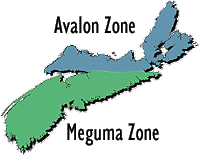| Global View - Where was Nova Scotia? By Early Devonian time, the
seas had receded. There were two main landmasses at this time. The southern continent
Gondwanaland consisted of South America, Africa, Madagascar, India, Australia and
Antarctica. The northern continent Laurasia consisted of North America, Greenland, Europe
and most of Asia. Movements of the earth's crust uplifted the land and brought the
continental landmasses closer together. When Gondwanaland and Laurasia came in contact
during the Middle Devonian, they fused together to produce one large supercontinent called
Pangea.
 Before this time, the Avalon and Meguma Zones of Nova Scotia were widely
separated because they belonged to different continental landmasses (Laurasia and
Gondwanaland, respectively). The formation of Pangea, however, joined them together for
the first time to form the single geological entity we now know as Nova Scotia. From the
Middle Devonian on, the province was in one piece and had a similar geological history
continuing to the present day. Before this time, the Avalon and Meguma Zones of Nova Scotia were widely
separated because they belonged to different continental landmasses (Laurasia and
Gondwanaland, respectively). The formation of Pangea, however, joined them together for
the first time to form the single geological entity we now know as Nova Scotia. From the
Middle Devonian on, the province was in one piece and had a similar geological history
continuing to the present day.
Geographically speaking, Nova Scotia was situated near the equator, wedged between the
North American and African continental plates.
Rocks of Nova Scotia
The union of the ancient continental landmasses initiated an impressive mountain
building episode called the Acadian Orogeny. The mountains produced by the Acadian Orogeny
(the Appalachians) may have been similar in appearance to the present day Canadian
Rocky Mountains.
The orogeny was nearing its completion in the Middle Devonian, with folding and
metamorphism of most rocks in Nova Scotia. Large volumes of rock were melted and the
resulting granitic magma was intruded into overlying rocks (about 370 million years ago),
forming the South Mountain batholith and the many other smaller intrusions. The numerous
metal deposits of southern Nova Scotia, including gold, are believed to have resulted from
the intrusion of these granites. During this time, the gabbroic and dioritic rocks at
Liscomb were intruded into the Meguma Group from deeper levels of the crust.
After the Appalachian Mountains were formed, there was a period of relaxation in which
the Earth's crust attempted to regain its equilibrium. This readjustment caused the
crust to break up along large faults into a series of " blocks". Some of these
blocks sank downward, while others were forced up. The uplifted blocks were rapidly
eroded, and the debris fell or was swept into the rift valleys created by the sunken
blocks.
Paleoenvironment
Primitive land plants found as fossils in both the Torbrook and Murphy Brook formations
of Nova Scotia suggest a uniformly warm and moist climate over a wide region in the Early
Devonian. Shallow water environments were inhabited by various plants and animals. Fish
were abundant, as were insects and other arthropods. Amphibians, the first animals to
breathe air, were on the rise.
Starting in the Middle Devonian, the climate changed gradually from warm and moist to
hot and arid. |
![]()